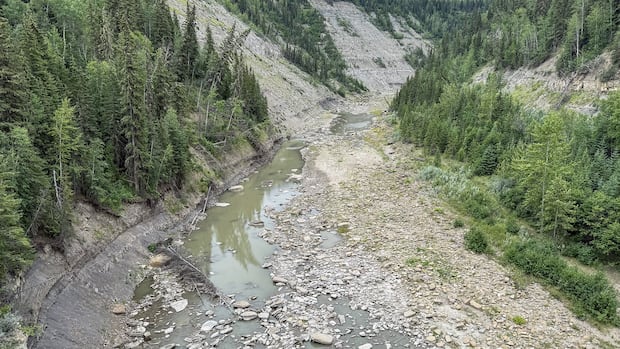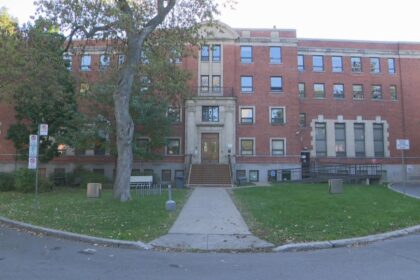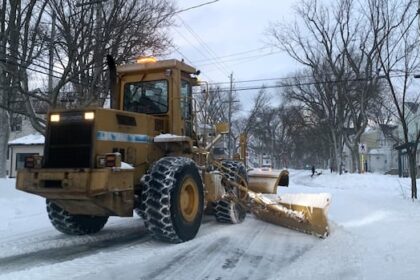British ColumbiaThe mayor of Dawson Creek. B.C., hopes his city will be connected to an emergency water supply within four to six weeks to help avoid a crisis this winter.City continues to pursue permanent pipeline connection to Peace RiverMatt Preprost · CBC News · Posted: Oct 15, 2025 9:52 PM EDT | Last Updated: 5 hours agoA section of the Kiskatinaw River near the community of Farmington, B.C., north of Dawson Creek. The river, which supplies drinking water for 15,000 people, has hit record low levels due to ongoing drought. (Matt Preprost/CBC)The mayor of Dawson Creek. B.C., hopes his city will be connected to an emergency water supply within four to six weeks to help avoid a crisis this winter.The northeast B.C. community declared a state of local emergency Tuesday, as an unprecedented drought throughout the region threatens its only source of drinking water.Mayor Darcy Dober says the emergency declaration will allow the city to pump water overland from the Peace River, about 50 kilometres north, to keep the city’s reservoirs replenished.”We need to overland pump water to our reservoirs to get us through the winter,” Dober told Radio West host Sarah Penton. “It’s something that’s going to have to take place before it gets extremely cold and before our reservoirs get empty.”The Kiskatinaw River, the city’s sole source of drinking water since 1942, is at record lows after four straight years of drought dating back to the 2021 heat dome. The river supplies about 15,000 residents in Dawson Creek and the surrounding area, including the village of Pouce Coupe.Right now, Dober says the city has about 150 days’ worth of water stored in its reservoirs. He says protecting essential services, including firefighting capacity, is the top priority as the city works to stretch what’s in storage.“If you don’t have secure water sources and we have an apartment building or something that starts on fire, and we don’t have the extra resources for [firefighters] to do their job, then you could be creating another emergency,” he said.The city continues to advance plans for a permanent, in-ground water pipeline and supply system from the Peace River. It’s a project expected to cost more than $100 million and take several years to complete. The city is asking the province to speed up approvals to get it built as soon as possible.Dawson Creek Mayor Darcy Dober says the city has about 150 days’ worth of water stored in its reservoirs. (City of Dawson Creek)“This isn’t the first time our community has been in a position of drought,” Dober said. “We’re very grateful for councils of the past and the city team that have invested in the infrastructure to really get the best they could have out of the Kiskatinaw River. Without that, we would be in a different position today.” But, he said, “we need to push along the permanent solution to this, so our community doesn’t have to face this again.”Stage 3 water restrictions, implemented in September, remain in effect. Dober says residents have already cut daily use from 6,000 cubic metres to 4,000.“Our community has done a phenomenal job of conserving water,” he said. Agriculture and Agri-Food Canada says below normal rainfall in September has increased the extent and severity of drought across much of B.C. and Western Canada. The winter precipitation forecast is mixed and uncertain.“There are some regions in Western Canada, including British Columbia, where the forecast is pointing to above normal precipitation,” said Trevor Hadwen, an agroclimate scientist with the department. “However, much of the country has equal chances of above, below, or near normal precipitation for the next three months.”“Based on this forecast, it’s very hard to determine if drought conditions will improve or degrade over the next several months,” Hadwen said. “In areas of severe and extreme drought, significant precipitation is required to alleviate the drought concern.”Bearhole Lake, a protected area in the eastern foothills of the Rockies, is the headwaters of the Kiskatinaw River. Both depend entirely on seasonal rain and snow.Dawson Creek officials estimate it could take up to eight years of above-average precipitation to restore the watershed to normal.Canadian drought conditions as of Sept. 30, 2025. (Agriculture and Agri-Food Canada)ABOUT THE AUTHORMatt Preprost is a reporter with CBC British Columbia based in Fort St. John, covering stories focused on the Peace Region and Northern Rockies. Email him at mathew.preprost@cbc.ca
Dawson Creek hopes to have emergency water supply in 6 weeks after declaring state of local emergency










